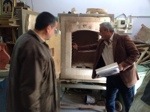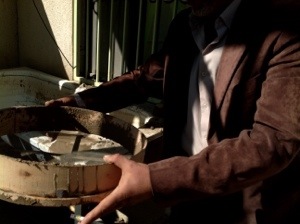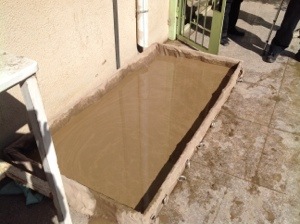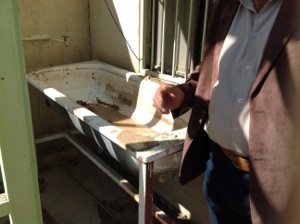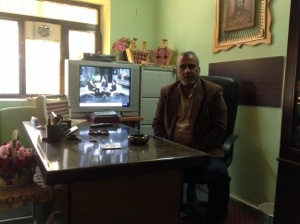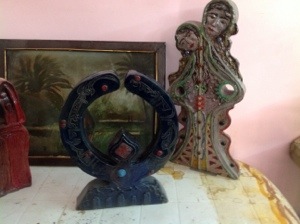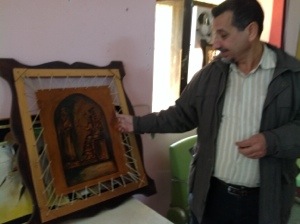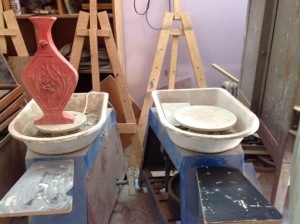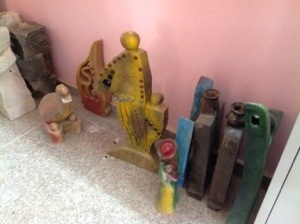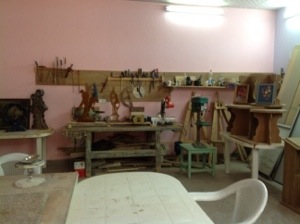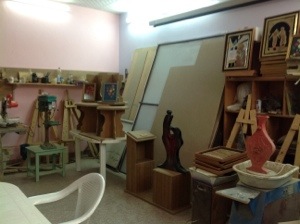Today we visited together with our good friend Amir Doshi the pottery laboratory of the Dhi-Qar directorate of education, directed by Qasim al Battat.
Here Nasiriyah students and teachers can learn or develop their skills on the manufacture of artistic objects in clay, bronze, wood, leather and other materials. They can also take lessons on painting held by Karim Dawood.
We were informed on the way in which they prepare clay for pottery making.
They gather clay from a site near Ur, digging at a deep of at least 1 m and a half. This clay is almost free of salt and dirties. The gathered clay is then sieved and put in water (they use for this a little tub ) for several days (at least three). The first day they put ¾ of water and one part of clay and then they wedge the soil in the water. During the night the clay deposits on the bottom of the tub so that in the second day they can remove the dirty water (they use a tube to suck away the water). They repeat this procedure at least three times until the clay is completely clean (the last time they put ¼ of water and ¾ of clay). After the clay is completely clean they put it in boxes covered by clothes by using wooden sieves. The clay is still too wet to be used so they let it dry under the sun (a procedure that is of course much quicker in Summer!).
The clay must be wedged and cut with a nylon string (they use the fishing line) in order to eliminate all the air bubbles.
Iraqi clay is considered very elastic. It usually has naturally sand inclusion but sometimes some sand can be added in order to make it suitable for pottery making.
We have been told that the temperature at which vases made with Iraqi clay are baked must not exceed the 900°.
Oggi abbiamo visitato insieme al nostro caro amico Amir Doshi il laboratorio di ceramica del Direttorato per l’educazione, diretto da Qasim al-Battat.
Qui gli studenti e i docenti di Nasiriyah possono imparare o approfondire la loro abilità nel realizzare oggetti artistici in argilla, bronzo, legno, pelle e altri materiali. Possono anche prendere lezioni di pittura con Karim Dawood.
Ci hanno raccontato il modo in cui preparano l’argilla affinché possa essere lavorata.
L’argilla proviene da una località molto vicina al sito di Ur ed è necessario scavare per almeno 1,5 metri. Questa argilla è priva di sale e di impurità. L’argilla raccolta viene poi setacciata e messa in acqua (usano per l’operazione una piccola vasca da bagno) per alcuni giorni. Il primo giorno mettono nella vasca ¾ di acqua e ¼ di argilla e poi mischiano e impastano il terreno nell’acqua. Durante la notte l’argilla si deposita sul fondo della vasca e così nel secondo giorno possono cambiare l’acqua sporca utilizzando semplicemente un tubo di plastica. Questa operazione viene ripetuta almeno tre volte sino alla completa pulitura dell’argilla (per l’ultimo ciclo usano ¼ di acqua e ¾ di argilla). Dopo la completa pulizia, mettono l’argilla in casse coperte di stracci prendendola con dei setacci. L’argilla è ancora troppo umida per essere usata e quindi viene lasciata al sole ad asciugare (una procedura che è ovviamente più veloce d’estate).
L’argilla deve essere molte volte impastata e tagliata con un filo (usano in genere una lenza da pesca) per eliminare dall’impasto tutte le bolle d’aria.
L’argilla irachena è molto elastica. Ha solitamente sabbia come incluso naturale ma a volte è necessario aggiungerne un po’ per renderla adatta alla lavorazione.
Ci è poi stato detto che l’argilla irachena deve essere cotta ad una temperatura non superiore ai 900°.
